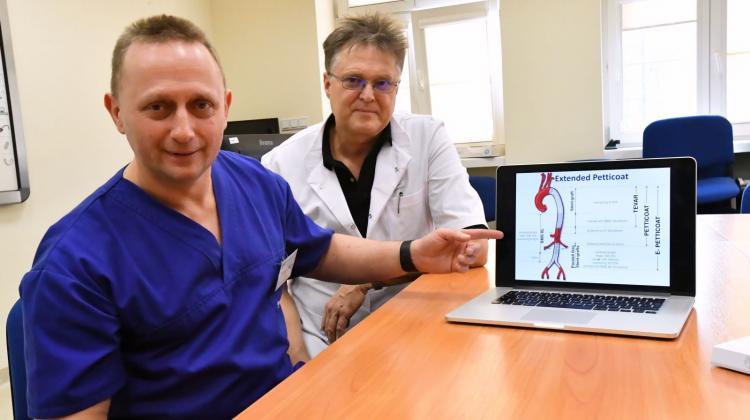Szczecin/ New method of treatment of aortic pathology with the approval of European experts
 Dr. Arkadiusz Kazimierczak (L) and Prof. Piotr Gutowski (P) during a meeting at the Independent Public Clinical Hospital No. 2 of the Pomeranian Medical University in Szczecin with the team of the Department of Vascular, General Surgery and Angiology, where a new method of treatment of aortic pathology was presented. Photo: PAP/Marcin Bielecki 06.02.2019
Dr. Arkadiusz Kazimierczak (L) and Prof. Piotr Gutowski (P) during a meeting at the Independent Public Clinical Hospital No. 2 of the Pomeranian Medical University in Szczecin with the team of the Department of Vascular, General Surgery and Angiology, where a new method of treatment of aortic pathology was presented. Photo: PAP/Marcin Bielecki 06.02.2019
The method of treatment of aortic dissection developed by vascular surgeons from Szczecin has gained the approval of European experts. The e-petticoat method is cheaper and thanks to it patients do not need further surgery.
"We were looking for a method that would be technically easy to perform for almost every vascular surgeon and would carry as little risk as possible" - said Dr. Arkadiusz Kazimierczak, a surgeon from the Department of Vascular, General Surgery and Angiology, Clinical Hospital No. 2 of the Pomeranian Medical University.
Three methods have been used in the treatment of aortic dissection: implantation of a stent-graft (a fabric tube on a metal scaffold that remains in the patient`s body permanently) in the thoracic aorta, petticoat (stent-graft with mesh) in the abdominal section, or petticoat, in which the true lumen of the aorta is widened with a balloon (stabilize method). It only allowed to treat the complications of aortic dissection in the acute phase of the disease. Only the most affected aortic segment was treated, and the rest would slowly degenerate; further procedures were necessary.
"In our extended petticoat (e-petticoat) method, by adding stent-grafts to the iliac arteries, we leave leaks between them, thanks to which blood flows into small sacral, intercostal and vertebral vessels" - explained Dr. Kazimierczak. He added that despite initial concerns about the possibility of aortic degeneration, it turned out that with this method its diameter did not increase, and the preserved flow channels in the false lumen (formed between the inner aorta wall and the medial wall) reduced the risk of neurological complications.
"The point is that it is possible to treat the patient +in one go+, so the patients come to us seriously ill, we treat them and they will not come back, they will not need further procedures" - explained Dr. Kazimierczak.
So far, this method has been used in over 50 patients. Surgeons emphasize that patients feel well and research is still ongoing.
"We initially had doubts that maybe we were overdoing the treatment, but it turned out that this was the right way. There are fewer complications, much better results, the risk paid off primarily for patients" - said Prof. Piotr Gutowski, head of the clinic where e-petticoat method was developed.
After three years of research, the e-petticoat method has been approved by European experts involved in the treatment of aortic dissection; the method has been described in the most important European vascular surgery journal - the European Journal of Vascular and Endovascular Surgery.
The common cause of aortic dissection is hypertension; it usually affects men about 50-60 years of age, but, as surgeons emphasize, there are also younger patients. In the dissecting aorta, its inner wall becomes separated from middle layer, and blood flows between them (into the false lumen), deepening the dissection. This creates an aneurysm, causing the risk of tearing the aortic wall. The tearing of the walls along the entire aorta cuts off the blood supply to the arteries that supply blood to the internal organs. The result is often ischaemia of the intestines and kidneys, which quickly leads to death. Ischaemia can also affect limbs and spinal cord, which causes severe ischaemia, and sometimes paralysis from the waist down. (PAP)
author: Elżbieta Bielecka
emb/ mhr/ kap/
tr. RL
Przed dodaniem komentarza prosimy o zapoznanie z Regulaminem forum serwisu Nauka w Polsce.















